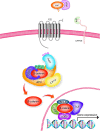HBV-related hepatocarcinogenesis: the role of signalling pathways and innovative ex vivo research models
- PMID: 31319796
- PMCID: PMC6637598
- DOI: 10.1186/s12885-019-5916-6
HBV-related hepatocarcinogenesis: the role of signalling pathways and innovative ex vivo research models
Abstract
Background: Hepatitis B virus (HBV) is the leading cause of liver cancer, but the mechanisms by which HBV causes liver cancer are poorly understood and chemotherapeutic strategies to cure liver cancer are not available. A better understanding of how HBV requisitions cellular components in the liver will identify novel therapeutic targets for HBV associated hepatocellular carcinoma (HCC).
Main body: The development of HCC involves deregulation in several cellular signalling pathways including Wnt/FZD/β-catenin, PI3K/Akt/mTOR, IRS1/IGF, and Ras/Raf/MAPK. HBV is known to dysregulate several hepatocyte pathways and cell cycle regulation resulting in HCC development. A number of these HBV induced changes are also mediated through the Wnt/FZD/β-catenin pathway. The lack of a suitable human liver model for the study of HBV has hampered research into understanding pathogenesis of HBV. Primary human hepatocytes provide one option; however, these cells are prone to losing their hepatic functionality and their ability to support HBV replication. Another approach involves induced-pluripotent stem (iPS) cell-derived hepatocytes. However, iPS technology relies on retroviruses or lentiviruses for effective gene delivery and pose the risk of activating a range of oncogenes. Liver organoids developed from patient-derived liver tissues provide a significant advance in HCC research. Liver organoids retain the characteristics of their original tissue, undergo unlimited expansion, can be differentiated into mature hepatocytes and are susceptible to natural infection with HBV.
Conclusion: By utilizing new ex vivo techniques like liver organoids it will become possible to develop improved and personalized therapeutic approaches that will improve HCC outcomes and potentially lead to a cure for HBV.
Keywords: Cell cycle; Hepatitis B virus; Liver cancer; Organoids; Wnt signalling.
Conflict of interest statement
The authors declare that they have no competing interests.
Figures





Similar articles
-
Are Humanized Mouse Models Useful for Basic Research of Hepatocarcinogenesis through Chronic Hepatitis B Virus Infection?Viruses. 2021 Sep 24;13(10):1920. doi: 10.3390/v13101920. Viruses. 2021. PMID: 34696350 Free PMC article. Review.
-
Application of human liver organoids as a patient-derived primary model for HBV infection and related hepatocellular carcinoma.Elife. 2021 Jul 30;10:e60747. doi: 10.7554/eLife.60747. Elife. 2021. PMID: 34328417 Free PMC article.
-
Up-regulation of human cervical cancer proto-oncogene contributes to hepatitis B virus-induced malignant transformation of hepatocyte by down-regulating E-cadherin.Oncotarget. 2015 Oct 6;6(30):29196-208. doi: 10.18632/oncotarget.5039. Oncotarget. 2015. PMID: 26470691 Free PMC article.
-
Heterogeneous phenotypes of Pten-null hepatocellular carcinoma in hepatitis B virus transgenic mice parallels liver lobule zonal gene expression patterns.Virology. 2022 Jan;566:16-25. doi: 10.1016/j.virol.2021.11.007. Epub 2021 Nov 23. Virology. 2022. PMID: 34844082 Free PMC article.
-
Molecular mechanistic insight of hepatitis B virus mediated hepatocellular carcinoma.Microb Pathog. 2019 Mar;128:184-194. doi: 10.1016/j.micpath.2019.01.004. Epub 2019 Jan 3. Microb Pathog. 2019. PMID: 30611768 Review.
Cited by
-
Downregulation of HBx Restrains Proliferation, Migration, and Invasion of HepG2 Cells.Anal Cell Pathol (Amst). 2021 May 13;2021:6615979. doi: 10.1155/2021/6615979. eCollection 2021. Anal Cell Pathol (Amst). 2021. PMID: 34094815 Free PMC article.
-
A Pleiotropic Role of the Hepatitis B Virus Core Protein in Hepatocarcinogenesis.Int J Mol Sci. 2021 Dec 20;22(24):13651. doi: 10.3390/ijms222413651. Int J Mol Sci. 2021. PMID: 34948447 Free PMC article. Review.
-
The Complex Role of HBeAg and Its Precursors in the Pathway to Hepatocellular Carcinoma.Viruses. 2023 Mar 27;15(4):857. doi: 10.3390/v15040857. Viruses. 2023. PMID: 37112837 Free PMC article. Review.
-
Preclinical Models of Hepatocellular Carcinoma: Current Utility, Limitations, and Challenges.Biomedicines. 2024 Jul 22;12(7):1624. doi: 10.3390/biomedicines12071624. Biomedicines. 2024. PMID: 39062197 Free PMC article. Review.
-
Pathogenesis of Hepatocellular Carcinoma: The Interplay of Apoptosis and Autophagy.Biomedicines. 2023 Apr 13;11(4):1166. doi: 10.3390/biomedicines11041166. Biomedicines. 2023. PMID: 37189787 Free PMC article. Review.
References
Publication types
MeSH terms
Grants and funding
LinkOut - more resources
Full Text Sources
Medical
Research Materials
Miscellaneous

